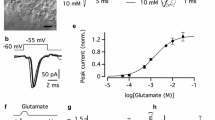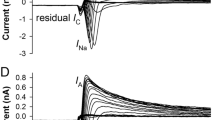Abstract
In Hermissenda type-B photoreceptors, the spike is generated in the axon and back-propagated to the soma, resulting in smaller somatic spikes. Experimentally, blocking the A-type K+ current (I K,A) results in broadening of somatic spikes. Similarly, in a compartmental model of the photoreceptor, reducing the maximum A-type K+ conductance (g K,A max) results in broadening of somatic spikes. However, simulations predict that little or no broadening of axonal spikes occurs when g K,A max is reduced. The results can be explained by the voltage-dependent properties of I K,A and the different potential ranges that the somatic and axonal spike traverse. Because of the steeper I-V curve and faster activation of the K+ channels at higher potentials, the recruitment of additional K+ channels in the axon is able to compensate for the decrease in K+ conductance, yielding less spike broadening. These results also support the idea that spike duration in the axon may not be reliably inferred based upon recordings collected from the soma.
Similar content being viewed by others
References
Acosta-Urquidi J, Crow T (1995) Characterization of voltage-dependent currents in Hermissenda type B photoreceptors. J. Neurosci. 15: 319–332.
Alkon DL, Fuortes MGF (1972) Responses of photoreceptors in Hermissenda. J. Gen. Physiol. 60: 631–649.
Baccus SA (1998) Synaptic facilitation by reflected action potentials: enhancement of transmission when nerve impulses reverse direction at axon branch points. Proc. Natl. Acad. Sci. U.S.A. 95: 8345–8350.
Borst JG, Sakmann B (1999) Effect of changes in action potential shape on calcium currents and transmitter release in a calyx-type synapse of the rat auditory brainstem. Philos. Trans. R. Soc. Lond. B Biol. Sci. 354: 347–355.
Cai Y, Flynn M, Baxter DA, Crow T (2002) Changes in spike width in soma may not reflect changes in axon. Soc. Neurosci. Abstr. 28: 446.19.
Cai Y, Baxter DA, Crow T (2003) Computational study of enhanced excitability in Hermissenda: membrane conductances modulated by 5-HT. J. Comput. Neurosci. 15: 105–121.
Cataldo E, Brunelli M, Byrne JH, Av-Ron E, Cai Y, Baxter DA (2005) Computational model of touch sensory cells (T cells) of the leech: role of the afterhyperpolarization (AHP) in activity-dependent conduction failure. J. Comput. Neurosci. 18: 5–24.
Debanne D (2004) Information processing in the axon. Nature Rev. Neurosci. 4: 304–316.
Debanne D, Guerineau MC, Gahwiler BH, Thompson SM (1997) Action-potential propagation gated by an axonal IA-like K+ conductance in hippocampus. Nature 389: 286–289.
Flynn M, Cai Y, Baxter DA, Crow T (2003) A computational study of the role of spike broadening in synaptic facilitation of Hermissenda. J. Comput. Neurosci. 15: 29–41.
Frick A, Magee J, Johnston D (2004) LTP is accompanied by an enhanced local excitability of pyramidal neuron dendrites. Nature Neurosci. 7: 126–135.
Frysztak RJ, Crow T (1994) Enhancement of type B and A photoreceptor inhibitory synaptic connections in conditioned Hermissenda. J. Neurosci. 14: 1245–1250.
Frysztak RJ, Crow T (1997) Synaptic enhancement and enhanced excitability in presynaptic and postsynaptic neurons in the conditioned stimulus pathway of Hermissenda. J. Neurosci. 17: 4426–4433.
Gandhi CC, Matzel LD (2000) Modulation of presynaptic action potential kinetics underlies synaptic facilitation of type B photoreceptors after associative conditioning in Hermissenda. J. Neurosci. 20: 2022–2035.
Geiger JR, Jonas P (2000) Dynamic control of presynaptic Ca2+ inflow by fast-inactivating K+ channels in hippocampal mossy fiber boutons. Neuron 28: 927–939.
Goldstein SS, Rall W (1974) Changes of action potential shape and velocity for changing core conductor geometry. Biophys. J. 14: 731–757.
Grossman Y, Parnas I, Spira ME (1979) Mechanisms involved in differential conduction of potentials at high frequency in a branching axon. J. Physiol. 295: 307–322.
Hochner B, Kandel ER (1992) Modulation of a transient K+ current in the pleural sensory neurons of Aplysia by serotonin and cAMP: implications for spike broadening. Proc. Natl. Acad. Sci. U.S.A. 89: 11476–11480.
Hochner B, Klein M, Schacher S, Kandel ER (1986) Modulation of a transient K+ current in the pleural sensory neurons of Aplysia by serotonin and cAMP: implications for spike broadening. Proc. Natl. Acad. Sci. U.S.A. 83: 8410–8414.
Hoffman DA, Magee JC, Colbert CM, Johnston D (1997) K+ channel regulation of signal propagation in dendrites of hippocampal pyramidal neurons. Nature 387: 869–875.
Hu H, Shao LR, Chavoshy S, Gu N, Trieb M, Behrens R, Laake P, Pongs O, Knaus HG, Ottersen OP, Storm JF (2001) Presynaptic Ca2+-activated K+ channels in glutamatergic hippocampal terminals and their role in spike repolarization and regulation of transmitter release. J. Neurosci. 21: 9585–9597.
Johnston D, Hoffman DA, Magee JC, Poolos NP, Watanabe S, Colbert CM, Migliore M (2000) Dendritic potassium channels in hippocampal pyramidal neurons. J. Physiol. 525: 75–81.
Klein M, Kandel ER (1978) Presynaptic modulation of voltage-dependent Ca2+ current: mechanism for behavioral sensitization in Aplysia californica. Proc. Natl. Acad. Sci. U.S.A. 75: 3512–3516.
Kopysova IL, Debanne D (1998) Critical role of axonal A-type K+ channels and axonal geometry in the gating of action potential propagation along CA3 pyramidal cell axons: A simulation study. J. Neurosci. 18: 7436–7451.
Lin X, Hant J (2001) Computer-simulation studies on roles of potassium currents in neurotransmission of the auditory nerve. Hear Res. 152: 90–99.
Luscher C, Streit J, Lipp P, Lucher HR (1994) Action potential propagation through embryonic dorsal root ganglion cells in culture. II. Decrease of conduction reliability during repetitive stimulation. J. Neurophysiol. 72: 634–43.
Parnas I, Hochstein S, Parnas H (1976) Theoretical analysis of parameters leading to frequency modulation along an inhomogeneous axon. J. Neurophysiol. 39: 909–923.
Schuman EM, Clark GA (1994) Synaptic facilitation at connections of Hermissenda type B photoreceptors. J. Neurosci. 14: 1613–1622.
Segev I (1990) Computer study of presynaptic inhibition controlling the spread of action potentials into axonal terminals. J. Neurophysiol. 63: 987–998.
Van Goor F, LeBeau AP, Krsmanovic LZ, Sherman A, Catt KJ, Stojilkovic SS (2000) Amplitude-dependent spike-broadening and enhanced Ca2+ signaling in GnRH-secreting neurons. Biophys. J. 79: 1310–1323.
Watanabe S, Hoffman DA, Migliore M, Johnston D (2002) Dendritic K+ channels contribute to spike-timing dependent long-term potentiation in hippocampal pyramidal neurons. Proc. Natl. Acad. Sci. U.S.A. 99: 8366–8371.
Ziv I, Baxter DA, Byrne JH (1994) Simulator for neural networks and action potentials: description and application. J. Neurophysiol. 71: 294–308.
Author information
Authors and Affiliations
Corresponding author
Additional information
Action Editor: Jonathan D. Victor
Rights and permissions
About this article
Cite this article
Cai, Y., Flynn, M., Baxter, D.A. et al. Role of A-type K+ channels in spike broadening observed in soma and axon of Hermissenda type-B photoreceptors: A simulation study. J Comput Neurosci 21, 89–99 (2006). https://doi.org/10.1007/s10827-006-7426-1
Received:
Revised:
Accepted:
Published:
Issue Date:
DOI: https://doi.org/10.1007/s10827-006-7426-1




